中西方餐桌礼仪的文化差异
餐桌礼仪在不同文化中各有何不同?
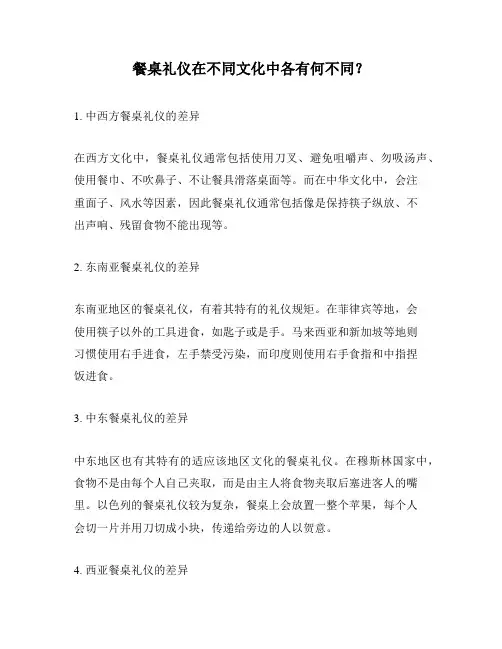
餐桌礼仪在不同文化中各有何不同?1. 中西方餐桌礼仪的差异在西方文化中,餐桌礼仪通常包括使用刀叉、避免咀嚼声、勿吸汤声、使用餐巾、不吹鼻子、不让餐具滑落桌面等。
而在中华文化中,会注重面子、风水等因素,因此餐桌礼仪通常包括像是保持筷子纵放、不出声响、残留食物不能出现等。
2. 东南亚餐桌礼仪的差异东南亚地区的餐桌礼仪,有着其特有的礼仪规矩。
在菲律宾等地,会使用筷子以外的工具进食,如匙子或是手。
马来西亚和新加坡等地则习惯使用右手进食,左手禁受污染,而印度则使用右手食指和中指捏饭进食。
3. 中东餐桌礼仪的差异中东地区也有其特有的适应该地区文化的餐桌礼仪。
在穆斯林国家中,食物不是由每个人自己夹取,而是由主人将食物夹取后塞进客人的嘴里。
以色列的餐桌礼仪较为复杂,餐桌上会放置一整个苹果,每个人会切一片并用刀切成小块,传递给旁边的人以贺意。
4. 西亚餐桌礼仪的差异在阿拉伯国家中,也有其特有的餐桌礼仪。
餐桌上通常会有一份文件表明客人的身份以及受邀请的原因。
在阿拉伯国家,想要表示尊重,应该称呼长辈和主人为“贵人”。
随后,就会有根据爱戴程度不同的饮食推荐和交流。
5. 日韩餐桌礼仪的差异日本和韩国的餐桌礼仪也与中国和西方的餐桌礼仪有所不同。
在日本,借口出去透透气而离开餐桌是一个不受欢迎的行为。
而在韩国,比如说你碰到了你不太熟悉的人,你应该用右手来拿好吃的东西然后用左手接过去。
如果你使用了错误的手,可能会被人认为不太友好。
另外,都可以吃得很慢,吃完不收拾干净总是会被视为不礼貌的行为。
总结,餐桌礼仪是文化和风俗的体现,不同的文化和地区有着各自的礼仪和规矩。
无论我们在什么地方,都应该了解该地区的餐桌礼仪,以表达对当地文化和人们的尊重和理解。
中西方餐桌礼仪文化差异总结
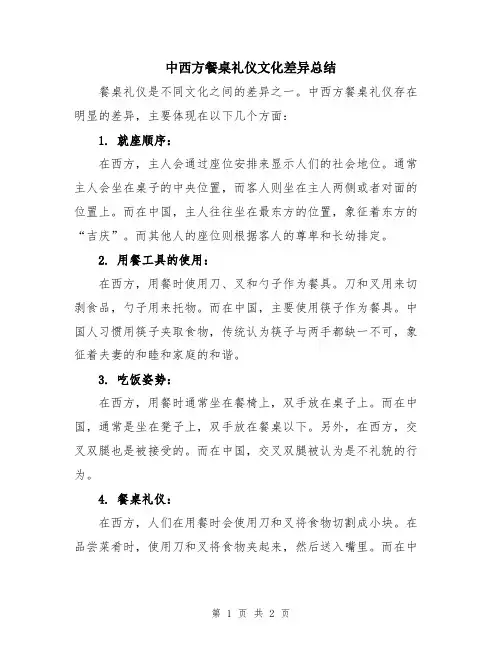
中西方餐桌礼仪文化差异总结餐桌礼仪是不同文化之间的差异之一。
中西方餐桌礼仪存在明显的差异,主要体现在以下几个方面:1. 就座顺序:在西方,主人会通过座位安排来显示人们的社会地位。
通常主人会坐在桌子的中央位置,而客人则坐在主人两侧或者对面的位置上。
而在中国,主人往往坐在最东方的位置,象征着东方的“吉庆”。
而其他人的座位则根据客人的尊卑和长幼排定。
2. 用餐工具的使用:在西方,用餐时使用刀、叉和勺子作为餐具。
刀和叉用来切剥食品,勺子用来托物。
而在中国,主要使用筷子作为餐具。
中国人习惯用筷子夹取食物,传统认为筷子与两手都缺一不可,象征着夫妻的和睦和家庭的和谐。
3. 吃饭姿势:在西方,用餐时通常坐在餐椅上,双手放在桌子上。
而在中国,通常是坐在凳子上,双手放在餐桌以下。
另外,在西方,交叉双腿也是被接受的。
而在中国,交叉双腿被认为是不礼貌的行为。
4. 餐桌礼仪:在西方,人们在用餐时会使用刀和叉将食物切割成小块。
在品尝菜肴时,使用刀和叉将食物夹起来,然后送入嘴里。
而在中国,使用筷子夹取食物是常见的做法。
而夹取食物时应该使用筷尖,而不是筷子的其他部分。
5. 餐前礼仪:在西方,餐前通常会有一段时间用于交流和饮酒。
主人会为客人倒酒,而客人则会向主人表示感谢。
而在中国,主人会以热水或茶的方式招待客人,并提供一些开胃小菜。
在中国,主人也会向客人倒酒,客人通常会表示感谢。
6. 餐后礼仪:在西方,人们通常会用餐结束后用纸巾擦拭嘴巴和手,并把纸巾放在餐盘上。
而在中国,人们通常会使用餐巾擦拭嘴巴和手,然后将餐巾折叠放在餐盘旁。
在西方,如果有剩余的食物,人们不会再食用,而是留下来作为下一顿的食材。
而在中国,剩余的食物通常会被认为是主人的问题,因此客人通常不会提前离开。
总之,中西方餐桌礼仪文化差异主要体现在就座顺序、用餐工具的使用、吃饭姿势、餐桌礼仪、餐前礼仪和餐后礼仪等方面。
这些差异反映了不同文化对于餐桌礼仪的理解和重视程度。
了解这些差异有助于加深不同文化之间的交流和理解。
中西方文化对比--餐桌礼仪
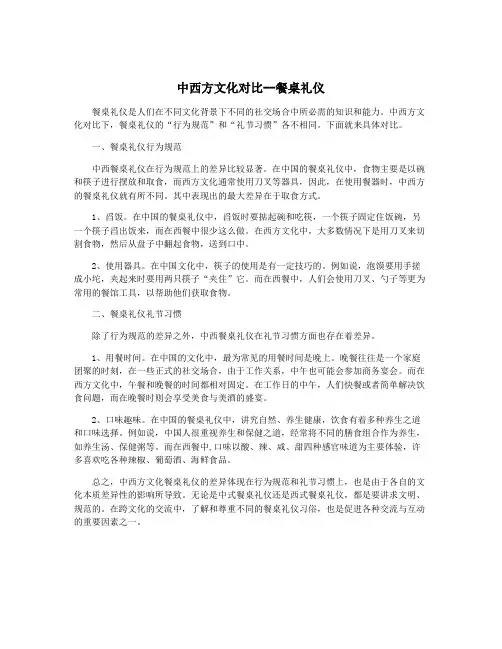
中西方文化对比--餐桌礼仪餐桌礼仪是人们在不同文化背景下不同的社交场合中所必需的知识和能力。
中西方文化对比下,餐桌礼仪的“行为规范”和“礼节习惯”各不相同。
下面就来具体对比。
一、餐桌礼仪行为规范中西餐桌礼仪在行为规范上的差异比较显著。
在中国的餐桌礼仪中,食物主要是以碗和筷子进行摆放和取食,而西方文化通常使用刀叉等器具,因此,在使用餐器时,中西方的餐桌礼仪就有所不同。
其中表现出的最大差异在于取食方式。
1、舀饭。
在中国的餐桌礼仪中,舀饭时要掂起碗和吃筷,一个筷子固定住饭碗,另一个筷子舀出饭来,而在西餐中很少这么做。
在西方文化中,大多数情况下是用刀叉来切割食物,然后从盘子中翻起食物,送到口中。
2、使用器具。
在中国文化中,筷子的使用是有一定技巧的。
例如说,泡馍要用手搓成小坨,夹起来时要用两只筷子“夹住”它。
而在西餐中,人们会使用刀叉、勺子等更为常用的餐馆工具,以帮助他们获取食物。
二、餐桌礼仪礼节习惯除了行为规范的差异之外,中西餐桌礼仪在礼节习惯方面也存在着差异。
1、用餐时间。
在中国的文化中,最为常见的用餐时间是晚上。
晚餐往往是一个家庭团聚的时刻,在一些正式的社交场合,由于工作关系,中午也可能会参加商务宴会。
而在西方文化中,午餐和晚餐的时间都相对固定。
在工作日的中午,人们快餐或者简单解决饮食问题,而在晚餐时则会享受美食与美酒的盛宴。
2、口味趣味。
在中国的餐桌礼仪中,讲究自然、养生健康,饮食有着多种养生之道和口味选择。
例如说,中国人很重视养生和保健之道,经常将不同的膳食组合作为养生,如养生汤、保健粥等。
而在西餐中,口味以酸、辣、咸、甜四种感官味道为主要体验,许多喜欢吃各种辣椒、葡萄酒、海鲜食品。
总之,中西方文化餐桌礼仪的差异体现在行为规范和礼节习惯上,也是由于各自的文化本质差异性的影响所导致。
无论是中式餐桌礼仪还是西式餐桌礼仪,都是要讲求文明、规范的。
在跨文化的交流中,了解和尊重不同的餐桌礼仪习俗,也是促进各种交流与互动的重要因素之一。
从餐桌礼仪中西方文化差异

从餐桌礼仪中西方文化差异餐桌礼仪在不同的文化中有着不同的规范和习惯,而西方文化和东方文化的餐桌礼仪也有很大的差异。
以下是一些从餐桌礼仪中体现出来的中西方文化差异:1.用餐时间和顺序:在西方文化中,用餐时间相对较早且时间较短,午餐和晚餐之间有较大的时间间隔。
而在东方文化中,人们会更加重视用餐的时间,餐桌上食物的进出也与西方文化不同。
在中国,通常会一道一道地上菜,而在西方国家,通常会所有的菜品一次性上齐。
2.刀叉的使用:在西方文化中,刀和叉是用来辅助进食的工具,刀用于切割食物,叉用于将食物送入口中。
刀和叉都是右手使用的,左手放在餐桌上。
而在东方文化中,餐桌上通常只有叉子和勺子,刀在做菜时使用,用餐时通常不会使用刀。
3.嘴部和手部的使用:在西方文化中,人们在用餐时,通常会直接用嘴来吃食物,用手拿食物是不礼貌的。
而在东方文化中,用手拿食物是被接受的,尤其是中国人常常会使用筷子来进食。
4.饮品的选择和顺序:在西方文化中,通常会在用餐之前享用一杯酒或清酒,而东方文化中,酒水的选择和饮用方式就不太一样了。
在中国,白酒是一种重要的饮品,人们通常在用餐时会互相劝酒,喝酒时要举杯敬酒,表达亲近和敬意。
5.面部表情和社交礼仪:在西方文化中,用餐时可以面带微笑,交流时也更加直接。
在东方文化中,用餐时通常保持比较庄重的面部表情,交谈时更加注重礼节。
6.残羹剩饭和桌上礼仪:在西方文化中,如果有剩余的食物,人们通常不会把剩下的食物带回家,而在东方文化中,尤其是中国文化中,把剩下的食物带回家是被接受的,甚至被视为节约和珍惜食物的表现。
总的来说,中西方文化在餐桌礼仪上有许多差异。
西方文化注重效率和个人的空间,因此用餐时间相对较短,嘴部和手部的使用也更加注重卫生。
而东方文化注重社会关系和礼节,因此用餐时间相对较长,人们用手拿食物是被接受的,交流时也更加注重礼节。
这些差异反映了中西方文化的价值观和社会习惯的差异,也丰富了人们对不同文化的理解和尊重。
中西方餐桌礼仪的文化差异
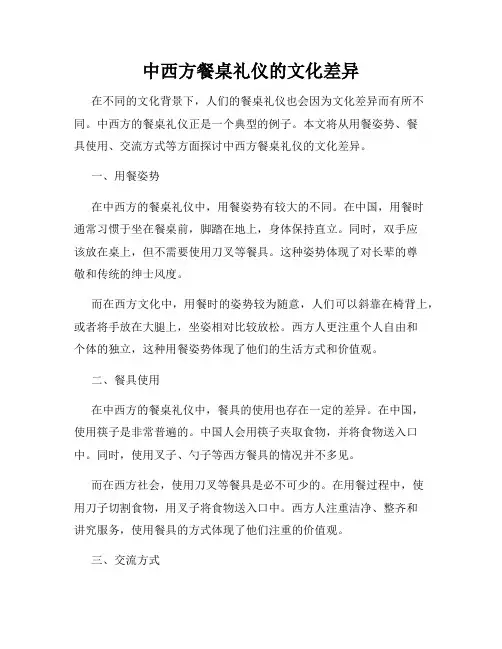
中西方餐桌礼仪的文化差异在不同的文化背景下,人们的餐桌礼仪也会因为文化差异而有所不同。
中西方的餐桌礼仪正是一个典型的例子。
本文将从用餐姿势、餐具使用、交流方式等方面探讨中西方餐桌礼仪的文化差异。
一、用餐姿势在中西方的餐桌礼仪中,用餐姿势有较大的不同。
在中国,用餐时通常习惯于坐在餐桌前,脚踏在地上,身体保持直立。
同时,双手应该放在桌上,但不需要使用刀叉等餐具。
这种姿势体现了对长辈的尊敬和传统的绅士风度。
而在西方文化中,用餐时的姿势较为随意,人们可以斜靠在椅背上,或者将手放在大腿上,坐姿相对比较放松。
西方人更注重个人自由和个体的独立,这种用餐姿势体现了他们的生活方式和价值观。
二、餐具使用在中西方的餐桌礼仪中,餐具的使用也存在一定的差异。
在中国,使用筷子是非常普遍的。
中国人会用筷子夹取食物,并将食物送入口中。
同时,使用叉子、勺子等西方餐具的情况并不多见。
而在西方社会,使用刀叉等餐具是必不可少的。
在用餐过程中,使用刀子切割食物,用叉子将食物送入口中。
西方人注重洁净、整齐和讲究服务,使用餐具的方式体现了他们注重的价值观。
三、交流方式在中西方的餐桌礼仪中,交流方式也呈现出差异。
在中国,用餐时,人们会不时地互道“请慢用”、“好吃吗”等礼貌性的问候。
此外,家庭聚餐时经常以围炉形式进行,家人间可以互相交流,加深彼此之间的感情。
而在西方文化中,用餐过程中通常会保持较为安静。
人们会专注于食物的品味,较少言谈。
这种做法体现了他们对食物的敬重,以及对用餐环境的重视。
四、就座次序在中国的宴会上,座次是一种非常重要的礼仪,尤其在正式的场合中更是如此。
主宾通常会被安排在宴会桌的中央位置,表示尊崇。
其他的客人则会根据年龄和地位来确定座位。
且与主人相对坐,彼此之间保持一定的距离。
而在西方文化中,座次的安排较为随意,没有太多的限制和规定。
人们可以自由选择座位,不需要拘束和担心座位的问题。
这种形式体现了西方文化中的人际平等和自由。
总结起来,中西方餐桌礼仪的文化差异主要体现在用餐姿势、餐具使用、交流方式和就座次序等方面。
中西方文化中餐桌文化礼仪的差异
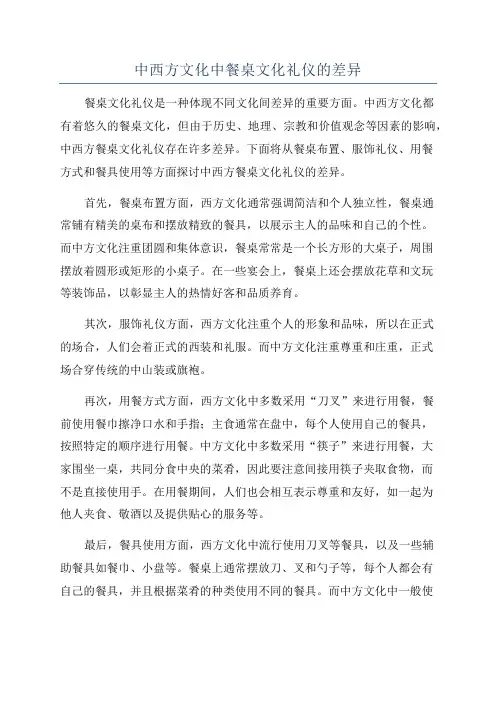
中西方文化中餐桌文化礼仪的差异餐桌文化礼仪是一种体现不同文化间差异的重要方面。
中西方文化都有着悠久的餐桌文化,但由于历史、地理、宗教和价值观念等因素的影响,中西方餐桌文化礼仪存在许多差异。
下面将从餐桌布置、服饰礼仪、用餐方式和餐具使用等方面探讨中西方餐桌文化礼仪的差异。
首先,餐桌布置方面,西方文化通常强调简洁和个人独立性,餐桌通常铺有精美的桌布和摆放精致的餐具,以展示主人的品味和自己的个性。
而中方文化注重团圆和集体意识,餐桌常常是一个长方形的大桌子,周围摆放着圆形或矩形的小桌子。
在一些宴会上,餐桌上还会摆放花草和文玩等装饰品,以彰显主人的热情好客和品质养育。
其次,服饰礼仪方面,西方文化注重个人的形象和品味,所以在正式的场合,人们会着正式的西装和礼服。
而中方文化注重尊重和庄重,正式场合穿传统的中山装或旗袍。
再次,用餐方式方面,西方文化中多数采用“刀叉”来进行用餐,餐前使用餐巾擦净口水和手指;主食通常在盘中,每个人使用自己的餐具,按照特定的顺序进行用餐。
中方文化中多数采用“筷子”来进行用餐,大家围坐一桌,共同分食中央的菜肴,因此要注意间接用筷子夹取食物,而不是直接使用手。
在用餐期间,人们也会相互表示尊重和友好,如一起为他人夹食、敬酒以及提供贴心的服务等。
最后,餐具使用方面,西方文化中流行使用刀叉等餐具,以及一些辅助餐具如餐巾、小盘等。
餐桌上通常摆放刀、叉和勺子等,每个人都会有自己的餐具,并且根据菜肴的种类使用不同的餐具。
而中方文化中一般使用筷子进行用餐,餐桌上通常摆放一把公筷,每个人使用自己的筷子夹取菜肴。
总的来说,中西方文化中餐桌文化礼仪存在很多差异。
西方文化强调个人独立性,使用刀叉进行用餐,并注重餐桌布置和服饰礼仪。
中方文化则强调团体意识,使用筷子进行用餐,并注重团圆和庄重的餐桌布置和服饰礼仪。
这些差异反映了不同文化间的价值观念和审美观的差异,也体现了不同文化对待饮食的态度和生活方式的不同。
中西方餐桌礼仪文化差异总结
中西方餐桌礼仪文化差异总结饮食文化、餐具、进餐方式以及一系列的餐桌礼仪等都反映了不同民族的社会生活样式和文化取向。
现代社会礼仪无处不在, 用餐不单是满足基本生理需要, 也是很重要的社交经验,而中西方在餐桌礼仪方面的要求也有许多差别,了解了两者的不同防止失礼于人.1.餐桌气氛上的差异总的来说是:西方餐桌上静,中国餐桌上动。
西方人平日好动, 但一坐到餐桌上便专心致志地去静静切割自家的盘中餐。
中国人平日好静,一坐上餐桌, 便滔滔不绝,相互让菜,劝酒。
中国人餐桌上的闹与西方餐桌上的静反映出了中西饮食文化上的根本差异。
2.邀请的提前与赴宴的守时的差异一般,不管是中方还是西方,邀请别人吃饭或者赴宴都要提前预定。
中方若是大型的婚宴请客要提前几天以上,这是表达一种对客人的尊重。
而西方宴请也要提前通知,像答应对方的邀请后,如果临时有事要迟到甚至取消约会,必须事先通知对方.另外,如果宴会时间是7点,你最好是6点55就要到。
赴会时稍迟是可以接受的,但若超过15分钟便会给对方不重视约会的坏印象。
3.中西方座次安排上的差异古代中国素有“礼仪之邦”之称,我国的传统作法是"以左为上",即认为居左之位高于居右之位。
并且先请客人入座上席,在请长者入座客人旁依次入座,入座时要从椅子左边进入。
入座后不要动筷子,更不要弄出什么响声来,也不要起身走动,如果有什么事要向主人打招呼。
而国际通行作法并排排列座次时,国际上的通行作法是“以右为上”,即认为居右之位高于居左之位.他们会注意:以主人和女主人为中心,左手的位置为上,靠近主人女主人的位置为上;夫妇不应相邻,男女依次相邻,主人和主方陪客应与客人依次相邻;译员可以坐在主宾的右侧。
有些大型场合,也可以在主人和主宾背后,另外安排用餐。
4.从餐具的摆放中看差异我们知道在中国的餐具中一般只有杯子,筷子,和碗、盘子等.它的摆放就相对比较简单。
餐具的摆放是这样的:大盘是离身体最近的,正对领带;餐布一角压在大盘之下,一角垂落桌沿;小盘叠在大盘之上;大盘左侧放手巾;左前侧放小碗,小瓷汤勺放在碗内;右前侧放置酒杯;右侧放筷子。
中西方餐桌礼仪的差异
中西方餐桌礼仪的差异:1、历史起源自古以来,中国就是“礼仪之邦”、“食礼之国”。
汉族传统的宴饮礼仪程序是:主人向客人发出请柬,届时主人在门口相迎。
出席的宾客也要互致问候,开席前客人先在客厅小坐,吃些茶点。
待客人到齐后一一就座,以左为上,相对上座的是二座,上座之下为三座。
等到客人都坐定之后,主人开始敬酒让菜。
敬酒时先敬长辈和主宾,最后才是主人。
这种传统的宴请礼仪在我国的大多数地方流传至今。
清代受西餐传入的影响,一些西餐礼仪也被引进,中西餐饮文化的交流,使得餐饮礼仪更加科学合理。
西方餐桌礼仪起源于法国,当时因着拜占庭文化启发,制定了一系列细致的礼仪。
在十七世纪以前,传统习惯是戴着帽子用餐。
在帝制时代,餐桌礼仪显得繁琐、严苛,不同民族有不一样的用餐习惯。
欧洲的餐桌礼仪由骑士精神演变而来。
在十二世纪,意大利文化流入法国,餐桌礼仪和菜单用语均变得更为优雅精致,教导礼仪的着作亦纷纷面世。
时至今日,餐桌礼仪还在欧洲国家继续传留下去。
西方家庭素有把餐桌当成课堂的习俗。
从孩子上餐桌的第一天开始,家长就对其进行餐桌礼仪的培养。
2、餐桌用语在中国,即使餐桌上的菜琳琅满目,主人也会说“菜很少,招待不周,还请大家多担待”;西方国家的主人则会很随便的说“help yourselves”,显得很自然随意。
同时中国的主人会不时往客人的碗里添布新菜,经常客人的碗被主人夹的菜装得满满的,但是在西方这是非常不礼貌的行为,主人的布菜会让客人觉得自己的意愿没有受到尊重。
3、餐具使用和摆放筷子刀叉是中西餐桌礼仪最基本差异。
在我国,北方多木,南方多竹,而筷子的主要原料就是木头和竹子。
而刀叉的起源与欧洲古代的游牧民有关,他们随身带刀,往往遇到猎物,用刀子割下来,烧熟了,用刀子分着吃。
大约到15世纪前后,为了改变进餐姿势,才慢慢开始使用叉子。
不同的餐具反映了不同的生活观念。
在中国,一家人坐在一起,用筷子合餐,体现了老老少少坐在一起的家庭单元,而西方人一开始就分吃,由此反映出西方人讲究独立子女长大后就独立闯世界的想法和习惯。
中西方餐桌礼仪文化差异总结
中西方餐桌礼仪文化差异总结文化差异是人类社会中普遍存在的现象,不同地区的餐桌礼仪文化也随之产生了差异。
中西方餐桌礼仪文化差异体现了不同文化在饮食习俗、用餐顺序、餐具使用等方面的不同观念和习惯。
本文将就中西方餐桌礼仪文化的差异进行总结和分析。
一、餐桌礼仪的意义中西方餐桌礼仪都有其独特的意义。
在中方文化中,餐桌礼仪被视为一种社交技巧,准确的餐桌礼仪可显示一个人的教养和修养,是考量一个人综合素质的重要标准。
而在西方文化中,餐桌礼仪更多地被视为一种文化传统和行为规范,具有尊重他人和维护社交秩序等深层次含义。
二、进餐方式的差异中西方的进餐方式存在显著差异。
在中方文化中,用筷子是主要的进食工具,将食物夹到自己碗中后放到嘴里,不常用刀叉。
而在西方文化中,刀、叉、勺是主要的进食工具,用刀切菜,用叉将食物放到口中,刀叉的使用技巧和顺序也有严格的规定。
三、就座次序的差异中西方的就座次序也有明显差异。
在中方文化中,就座通常是按照地位、长幼来规定的,从长辈到晚辈的顺序依次就座。
而在西方文化中,就座次序则更加注重个人自由和平等,就座通常没有固定的次序,客人可以按照自己的喜好选择座位。
四、餐桌礼仪细节的差异在餐桌礼仪的细节上,中西方文化也存在诸多差异。
比如在中方文化中,使用筷子时应该扎菜根,夹菜时不要用筷子指头指着别人,饭碗不可高高举起等;而在西方文化中,吃饭时应保持坐姿端正,切菜时要谦和地使用刀和叉,不可伸长手臂距离过远等。
五、餐桌礼仪的其它差异此外,中西方餐桌礼仪文化还在不同方面存在差异。
在中方文化中,吃饭时吵闹和大声嚼食是不礼貌的行为,家庭成员之间常常互相夹食物表示亲情的表达。
而在西方文化中,吃饭时和家人、朋友之间的交流更为活跃,大声说话被视为互动和社交的一部分。
总结起来,中西方餐桌礼仪文化差异体现了不同文化对待饮食和社交的不同观念和习惯,彰显了不同文化之间的独特魅力。
了解和尊重他人的餐桌礼仪是跨文化交流和国际交往中的重要一环。
中西方餐桌礼仪的差别
中西方餐桌礼仪的差别了解中西方餐桌礼仪文化差异可以避免因为不恰当的方式或行为造成误解和交际障碍。
本文为大家整理了中西方餐桌礼仪的差别,仅供参考!中西方餐桌礼仪的差别一1 .气氛上的差异总的来说是西方餐桌上静,中国餐桌上动。
西方人平日好动,但一坐到餐桌上便专心致志地去静静切割自家的盘中餐。
中国人平日好静,一坐上餐桌,便滔滔不绝,相互让菜,劝酒。
中国人餐桌上的闹与西方餐桌上的静反映出了中西饮食文化上的根本差异。
2. 餐桌举止在中国文化传统中,人们在出席各种正式的会餐时也是比较讲究的,但是在现代风俗变迁和发展中,有进步的一面,也有落后的一面,有对传统的观看来,这种超负荷的饮食不仅造成浪费,而且危害人体。
尽管中国人讲究食疗、食养,重视以饮食来养生滋补,但我们的烹调却以追求美味为第一要求,致使许多营养成分损失破坏,因此营养问题也许是中国饮食的最大弱点。
3. 西方烹调遵循的是规范与科学西方人强调科学与营养,因此烹调的全过程都严格按照科学规范行事。
菜谱的使用就是一个极好的证明。
西方人总是拿着菜谱去买菜,制作菜肴,但相比起来,还是一个非常机械的东西,而这导致了西餐的一个弊端)))缺乏特色。
当人们身处异地想品尝当地美食时,肯定是不会有人选择肯德基或麦当劳之类食品的。
另外,规范化的烹调甚至要求配料的准确,调料的添加精确到克,烹调时间精确到秒。
由于西方菜肴制作的规范化,使其毫无创造性。
令西方人不能理解的是,中国烹调不仅不追求精确的规范化,反而推崇随意性。
翻开中国的菜谱,常常发现原料的准备量、调料的添加量都是模糊的概念。
而且中国烹调中,不仅讲究各大菜系要有各自的风味与特色,即使是同一菜系的同一个菜,所用的配菜与各种调料的匹配,也会依厨师的个人爱好特点有变化。
同样是一道/麻婆豆腐,为四川客人烹制和为苏州客人烹制,所用的调料肯定是不同的。
而在西方,一道菜在不同的地区不同的'季节面对不同的食者,都毫无变化。
4. 崇尚自由的西方人重分别与个性在中西饮食文化之中也明显体现出这种文化特征。
- 1、下载文档前请自行甄别文档内容的完整性,平台不提供额外的编辑、内容补充、找答案等附加服务。
- 2、"仅部分预览"的文档,不可在线预览部分如存在完整性等问题,可反馈申请退款(可完整预览的文档不适用该条件!)。
- 3、如文档侵犯您的权益,请联系客服反馈,我们会尽快为您处理(人工客服工作时间:9:00-18:30)。
中西方餐桌礼仪的文化差异CULTURAL DIFFERENCES OF TABLE MANNERS BETWEEN EAST AND WESTAbstract and Key WordsAbstract:Table manners are the rules of etiquette used while eating. Different cultures observe different rules for table manners. This article has some contrastive analysis and research onthe cultural differences of table manners between East and West from the point of view onsense of arriving time, seat arrangement, order of serving dishes, tableware, b ehaviourand communication. It is concluded that with the wide spreading of interculturalcommunication people in East and West are deeply transformed,permeated and accepted toone another. They come to respect and tolerate different table manners, thus are evenassimilative and syncretize with each other.Key words: table manners; cultural differences; syncretism摘要:餐桌礼仪是用餐时的礼仪规则。
不同的文化遵循不同的餐桌礼仪规则。
本文从时间观念、座次安排、上菜顺序、餐具、行为和语言几个方面对中西方餐桌礼仪的文化差异做出对比分析,并由此得出结论,随着跨文化交际活动越来越广泛,中西方人经历了深刻的转变,从相互渗透到彼此接受,人们逐渐能够尊重和容忍不同文化的餐桌礼仪,甚至趋于同化和融合。
关键词:餐桌礼仪;文化差异;融合CONTENTS1. Introduction (1)2. Literature Review (1)3. Cultural Differences of Table Manners (2)3.1 Sense of Arriving Time3.2 Seat Arrangement3.3 Order of Serving Dishes3.4 Tableware3.5 Behaviour and Communication4. Main Factors Causing the Differences (6)4.1 Geography4.2 Tradition4.3 Custom5. Trend of Syncretism (7)6. Conclusion (9)Bibliography (9)Acknowledgements (10)Cultural Differences of Table Manners betweenEast and West1. IntroductionWith the rapid development of economy and culture, having meals is not only for the basic physical satisfaction, but also the important skill in social communication. Striving for civic virtues and having good manners have become increasingly common understanding of the public.In China, which has been a nation of etiquette and particular about food being the first necessity of the people since antiquity, table manners has a long history and has naturally become an important part of dining culture. With the deepening of open policy in our country and the strengthening of communication between East and West, people have more and more opportunities to cooperate with foreigners. Naturally, Chinese cannot avoid having dinners with foreigners. A series of table manners including sense of arriving time, seat arrangement, order of serving dishes, tableware, behaviour and communication reflect different culture and life-style in nations or countries. There are many differences of table manners between eastern and western countries.To understand these differences can not only avoid committing a breach of etiquette to each other, but also promote the development of humanity culture in both countries and achieve interpersonal harmony in cross-cultural communication.2. Literature ReviewAs we all know, different countries have different cultures. Culture is the collective programming of the mind which distinguishes the members of one category of people from another (Hofstede, 1991). As a kind of social customs, table manners are influenced by culture and vary in different areas. China, known as civilized ancient country, has characteristic table manners with a long history. Western countries also formed their own table manners during the syncretism of nations and modernization. To a certain degree, having good table manners is a symbol of a nation's civilization and an expression of a person's moral cultivation and accomplishment level as well.With the deepen of open policy in our country and the strengthen of communication between East and West, it is necessary for us to improve the consciousness of cross-cultural communication and know the differences of table manners, such as sense of arriving time, seat arrangement, order of serving dishes, tableware, behaviour, communication and so on. The fully understanding of thedifferences can prevent the failure in politeness and promote personal status on the dinner table. Only if we realize cultural connotation of table manners and the differences between East and West, can we talk and behave decently in cross-cultural communication and make social communication harmonious.With an acute eye and an irrepressible wit, Margaret Visser takes a fascinating look at the way we eat our meals in the book The Rituals of Dinner. From the ancient Greeks to modern yuppies, from cannibalism and the taking of the Eucharist to formal dinners and picnics, she thoroughly defines the eating ritual. She takes the different table manners in different areas and races to show the development of the world civilization. In the book Culture on Dinner Table, Mr. Yi Zhongtian (2004) says that the core thought of Chinese culture is group consciousness while the western core thought is individual consciousness. Westerners order respective dishes by themselves rather than ask others for what they want. On the contrary, Chinese agrees that personal will should obey group common thought. In the book Differences and Syncretize of Etiquette Culture between East and West, Mr. Li Xiaojun explores the syncretism of etiquette culture between East and West on the basis of table manners to achieve the harmonious society. Yu Lin and Zhou You compare the cultural differences between East and West from the point of view on tableware, seat arrangement, dinner atmosphere and language. It aims at warning people to treat exotic culture with an objective, tolerant and respectful attitude while insisting on their own culture, in order to communicate properly and appropriately in cross-cultural communication.3.Cultural Differences of Table Manners3.1 Sense of Arriving TimeHall has classified two kinds of people according to his observation. One is monochromic time and the other is polychromic time (Edward Hall, 1976:17). People from western countries hold monochromic time assuming time is linear and can be cut, so they pay much more attention to timetables and pre-arrangements. They are slaves to nothing but the clock, and time is treated as if it were something almost precious. While people from eastern countries insist on polychromic time, having no ideas of fixed timetable. Therefore, this difference is more obvious when attending a banquet.Generally speaking, Chinese people which holding polychromic time tend to be later to show up. They often arrive half an hour later than the prescribed time and the host also seems to have prepares for that. They always arrange some other programs for guests while waiting, such as playing cards, drinking tea or chatting, so that the guests who come earlier would not feel boring. Both the host and guests are used to this phenomenon and they do not regard this as a contempt or impolite behavior tothe host. While in western countries, people do things strictly abide by the schedule and all the activities begins according to the predetermined time. People should arrive at the party on time especially the formal banquets. It is considered as impolite and contempt for the host and other guests if one arrives 10 minutes later.3.2 Seat ArrangementThe seating arrangement is probably the most important part of Chinese table manners. The seat of honor, reserved for the master of the banquet or the guest with highest status, is the one in the center facing east or facing the entrance. Those of higher position sit closer to the master of the banquet. The guests of lowest position sit furthest from the seat of honor. If the guest of honor is not seated, other people are not allowed to be seated. And i f he hasn’t eaten, others should not begin to eat. When a family holds a banquet, the seat of honor is for the guest with the highest status and the head of the house takes the least prominent seat. If it is a round table, then the one facing the entrance door is the guest of honor. The seats on the left hand are in turn second, fourth and sixth, etc, while those on the right hand are in turn third, fifth and seventh, etc, until they join together. In ancient times there was a piece of furniture known as an Eight Immortals table, a big square table with benches for two people on each side. If it is an Eight Immortals table and there is a seat facing the entrance door, then the right seat facing the entrance door is for the guest of honor. If there is no seat facing the entrance door, then the right seat facing the east is the seat of honor. Then the seats on the left side of the seat of honor are the second, fourth, sixth and eighth and those on the right side are the third, the fifth and the seventh.While in western countries, after the hostess announced dinner ready, male host will lead guests to the table in turn, and the hostess walks behind them. Some attentive host will also place name card on the table to show the seat. If there has no arrangement, the general principle for seat arrangement is that men and women sit separately. Men guests of honour take the prior seats which on the right hand of hostess while women guests of honour seat on the right hand of him, and the other couples sit in diagonal respectively. Men and women sitting separately shows the open and lively of the American banquet. It can promote the familiarity between each other and make the dining topic diversification and dining atmosphere peaceful. The principle for the seat arrangement is that the guest takes the seat first, the elderly prior to young people, the married prior to unmarried and stranger prior to the acquaintance and families.3.3 Order of Serving DishesIn China, many dishes have symbolic connotations, representing everything from wealth to a longlife and the order of serving dishes shows Chinese characteristics. A Chinese meal begins with appetizers which are accompanied by beverage and wine. There are usually four or five of these appetizers, including cold meats, preserved eggs, smoked fish and vegetable relishes, all beautifully arranged either on separate dishes or on one large platter. Hot dishes that were boiled or poached are usually served first, followed by foods that were fried, such as stir-fried chicken and stir-fried shrimp, which are omitted most of the time. Hot food should be served from the left of the opposite seats of guests of honour. When serving the whole duck, chicken and fish, the head and tail can not be put toward the major seat. After the hot dishes, then comes the main course, rice, which is China's staple food. While in a feast or banquet, people always eat little because of the abundant of the food. At last, desserts and fruits are provided to help digestion. If there are lots of tables on the banquet, every dish should be served simultaneously. These programs can not only make the whole process in harmony and order, but also make host and guests expression and communication well. Therefore, the table manners can make the dinner perfect and make host and guests both cultivation fully display.In western countries, the first dish is also appetizer which with distinctive flavor. It is always with salty and acid taste and small quantity but high quality. The second dish is soup, which very different from China. The soup can be roughly divided into four categories of clear soup, cream soup, vegetable soup and cold soup. Generally, the third dish is fish dish, also known as side dish, which including many kinds of fish, shellfish and molluscs. As fish is easy to digest, it is served in front of meat dishes. Meat and poultry dishes is the fourth dish, which also known as the main course. The most representative is beef and steak. Vegetable dishes, called salad in western, can be arranged either after or with the meat dish, so it can be a kind of side dish. The six dish is dessert, which including all the food after the main course in a sense, such as pudding, ice cream, cheese, fruit and so on. The final is beverage that often includes coffee with cream or tea with sugar.3.4 TablewareOf course, the main difference on the dinner table between East and West is the different tablewares. Chopsticks, which have a long history, are the most important tableware in China. The tradition of using chopsticks as tableware was introduced to many other countries in the world. The invention of chopsticks reflects the wisdom of Chinese ancient people. A pair of chopsticks, though they look simple, can nip, pick, rip and stir food. When having a meal, chopsticks should be put tidily on the right of the bowl. When finishing a meal, they should be put vertically on the mid-line of the bowl. Spoon is mainly used to drink soup or take quite small food. Do not get too full when using the spoon to get food, lest overflow make the table and clothes dirty. Plate is mainly used to fill the food, according the amount and shape of food it served. The plate that slight small should be put on the leftof bowl to temporarily put food taken from the public dishes. Food wastes and bone should be put in the front of the small plate with chopsticks instead of directly spitting into it.Generally speaking, people do not use much tablewares when having meals in China. Chinese people mainly use bowl, chopsticks and spoons. While in serving English meals, they use so much tablewares with different kinds and sizes. For example, there are different kinds of glasses in English, such as wine glass, cherry glass, brandy glass, beer glass, snifter glass, champion flute and high bowl. The use of tableware also shows different food culture in different countries. The main tablewares in western are knives, forks, spoons, glass and napkin. To start with, the fork is on the left side of the plate and the knife is on the right side. The knife which used to cut food into small pieces should be hold in the right hand. The fork and spoon can be placed either on the left or right hand of the table with the plate in the middle, depending on the person's preference on using the tableware. In general, the spoon is usually for soup.When using the spoon, start from the one closest to the bowl which closest to you and ladle out soup then sip from the spoon. If no soup is being served then it's meant for dessert. If you are right handed, then the knife goes into your right hand, fork in your left hand, and using the knife for cutting and eating with the fork. Some people refer to cut their meat or other items on their place into small pieces all at once and then just use their fork in their right hand and in most instances this is still considered good table manners.3.5 Behaviour and CommunicationChinese people talked a lot and enjoy the delicious food when on the dinner table, which can reflect the hospitality and sincere of hostess. The lively atmosphere on the dinner table reflects the cheerful of guests, and it can reflect the warmth of family, the peace of neighbourhood and unite of the whole nation in a sense. While in western, people talked little and cut their own food in the plate quietly. They should not make any sounds when drinking and eating. If the soup is hot, they should wait instead of blowing with mouth.When Chinese invited guests to have dinner, there are so many dishes on the table, at least seven dishes. But host will say “There are not so much food for you all.”“The dish does not cook well.” and similar words. If the host asks “Would you like some more?”, then the guest may answer “No, thank you. I am full.”even if he is not full. After the host ask for many times, they maybe accept with embarrassment and little shameful. While in western, a dinner generally has four or five dishes and the host will simply say “Help yourself, please”. When the host asks “Would you like another piece of meat pie?”, you can answer directly “Yes, please.” or “Thank you, a piece of meat pie.” if you are not full. During the dinner, guests can praise the host such as “It is delicious.” or “This meat is beautifully tender.” to make host happy. Chinese followed the principle that belittle themselves and respect others. While westerners emphasize efficiency and pragmatism values and pay much attention to saving faceand keeping their prestige.4. Main Factors Causing the Differences4.1 GeographyAs we all know, different areas have different culture and custom. Because of the different location, natural conditions and geographical environment, different areas formed different regional culture which shows in that different nationalities using different language expression forms for the same kind of phenomenon or things. The geographical location and the environment lead to the differences between Chinese and western cultures. China is a big country with a vast territory ab ounding in natural resources, and the people’s way of life, customs, economic and cultural development, as well as general local conditions, all vary.For example, Chopsticks and, knife and fork is the most basic differences between Chinese and western table manners. You Xiuling, the professor of Zhejiang University, said that east and west appear different tablewares are related to the environment. Chopsticks should be originated in the place of lots of bamboo. There are much wood in north China and much bamboo in south China. So ancestors use local materials to make chopsticks and they became China's most primitive raw materials of chopsticks. The emergence of knife and fork is much later than that of chopsticks. According to the research of professor You Xiuling, the origin of knife and fork is related to the life habit of ancient European nomads, who always took knife along them and live on horseback. They cut down and eat meat as soon as it cooked. From then on, westerners use knife and fork as their tablewares.4.2 TraditionThe different ethnic and national historical development process may result in different history and tradition. Thousands of years of Chinese traditional culture reflected in the Chinese Confucianism, Taoism and Buddhism. As the core of Chinese traditional culture, Confucianism produces a profound and long influence on Chinese society. Confucianism has the traditional thought mainly emphasized “benevolence, righteousness, propriety, wisdom, faith”. Taoists advocated “accustomization nature”, “pure”and he Buddhist is advocated “merciful Purdue beings”and “harmony”, “continued”. In the book Culture on Dinner Table, Mr. Yi Zhongtian said that the core thought of Chinese culture is group consciousness while the western core thought is individual consciousness. In sharp contrast, the western culture is a kind of “guilt”culture. They believe in god created man. The western culture, to be self-centered, the boundary between people is clear and they do not allow mutual interference. This individual culture contributed to western table manners without sharing a plate of food. But Chinese love peace and quiet life in the forest, and in the dining room use cheap chopsticks as tableware. Thechopsticks can also reflect Chinese collective consciousness. Westerners prefer to colonize in restaurants, use a knife and fork in the class. Knife and fork also can reflect individual consciousness, and noble west of life.From the use of chopsticks we can see the whole course of using chopsticks is collaborative work. If one of them is absent, the whole work cannot be completed. It shows that collectivism is the core thought of Chinese nation. And knife and fork is born in modern industrial society, which is the production of socialization. Its main material is metal which shows social function of modern society, and failed to get rid of its offensive during socialization process.4.3 CustomCustom culture refers to the culture that formed in the daily social life and human communication activity by ethnic and habits. The differences of custom between east and west are various. Different nationalities show different ethnic culture and custom on many aspects such as greeting, thanks, flattery, apology, or making telephone calls. For example, when Chinese meet acquaintance, they always greet each other by asking “have you eaten”or “where are you going”. While in western culture, it does not belong to the greeting but a real problem. They may think “why does he ask me whether I have eaten”“does he want to invite me to have dinner”. When Chinese invited guests to have dinner, there are so many dishes on the table, but host says repeatedly “there is nothing for you”“have a potluck” and similar words. The host also helps pick food for guests and try his best to make guests eat and drink more. Westerner often doubted about this phenomenon. It is not realistic behaviour that host said there is nothing when there are so many dishes on the table. And their meal is very simple which often with a small number of delicious vegetables when they treat others. Host just says “help yourself” and they never carry food to guest's bowl.5. Trend of SyncretismAs a country that pays great attention to courtesy, the cuisine culture is deep rooted in Chinese history. In either a Chinese home or restaurant, it is easy to find that table manners are essential. And the distinctive courtesies displayed will invariably add to the enjoyment of meals and keep people in high spirits. It is really an admirable custom to respect others at the table, including the aged, teachers and guests while taking good care of children. Chinese people stress filial piety all the time. The practice of presenting the best or fine food first to the senior members of the family has been observed for countless generations. In ancient times the common people led a needy life but they still tried their best to support the elder mother or father who took it for granted. Although the hosts in China are all friendly and hospitable, we should also show them respect. Before starting to eat dinner, the host mayoffer some words of greeting. Guests should not start to eat until the host says, 'Please enjoy yourself' or something like that, otherwise it suggests disrespect and causes displeasure. When hosts place dishes on the table, they will arrange the main courses at the center with the supporting dishes evenly placed around them. When the main dishes are prepared in a decorative form either by cut or other means they will be placed facing the major guests and elder people at the table, which also embodies virtue. Westerners have gradually accepted Chinese sentimental thought. And Chinese food has always been very popular in America. Many Americans grew up frequently eating lunches with dishes like wonton soup, chow mein and fried rice.There are abundant and extensive table manners forming in the east, while there are exquisite and distinctive table manners forming in the west. Nowadays, the trend of syncretism of table manners between east and west is mainly reflected in Chinese learning from westerners. More and more western restaurants appear in many cities in China and more and more people like to have meals in it. People have learned western table manners gradually in daily life. It is obvious that the Chinese diet conception is sensible, western diet idea is rational. This difference seems to become blurred with the strengthening of communication between East and West and the development of science. Like westerners, instead of paying attention to the color, flavour and taste of the food, Chinese people pay more attention to its health and nutrition. We should learn from western manners not only learn its form but also adopt its inner spirit. Only in this way can we build up our confidence and superiority and establish our appeal. And western style food, which was introduced into our country several hundred years ago, has grown up to be a vital new force on the Chinese food and beverage market. The dissemination and development of western style food in China has unavoidably exerted great influence on Chinese food and beverage industry and made Chinese style food trade change in the aspects of managing concept, management mode, productive means, personnel cultivation and so on.6. ConclusionTable manners reflect many differences between east and west, whether on sense of arriving time, seat arrangement, order of serving dishes, tableware or behaviour and language. Knowing the differences people can easily understand the culture of each other. In face of these differences, we should comprehend and respect their habits and culture and should remember that every culture is equal and there is no one prior to the other. Thus we can decently communicate with each other. Only recognizing cultural differences between East and West and making a reasonable and effective integration, can we establish a social cultural etiquette system of contemporary China and reach the ideal harmonious society.Bibliography[1]Albala, K. The Cambridge World History of Food [M].Cambridge:Cambridge University Press,2000.[2]Finn, Carrie. Manners at the Table [M]. America:Picture Window Books,2007.[3]King, Mia. Table Manners[M]. America:Berkley Trade,2009.[4]李晓军. 中西礼仪文化的差异与融合[J].内江科技,2007(03).[5]玛格丽特﹒维萨.餐桌礼仪[M].刘晓媛译.北京:新星出版社,2007.[6]彭健. 浅议中西餐桌礼仪差异[J]. 新西部(下半月), 2009(06).[7]余琳,周游. 从餐桌礼仪看中西文化差异[J]. 硅谷, 2008(18).[8]杨柳,田丹丹,苑富山. 中美餐桌礼仪刍议[J]. 内江师范学院学报, 2008(01).[9]易中天. 餐桌上的文化[J]. 当代学生, 2004(10).[10]张亚红. 中西方饮食文化差异以及餐桌礼仪的对比[J]. 边疆经济与文化, 2009(04).。
